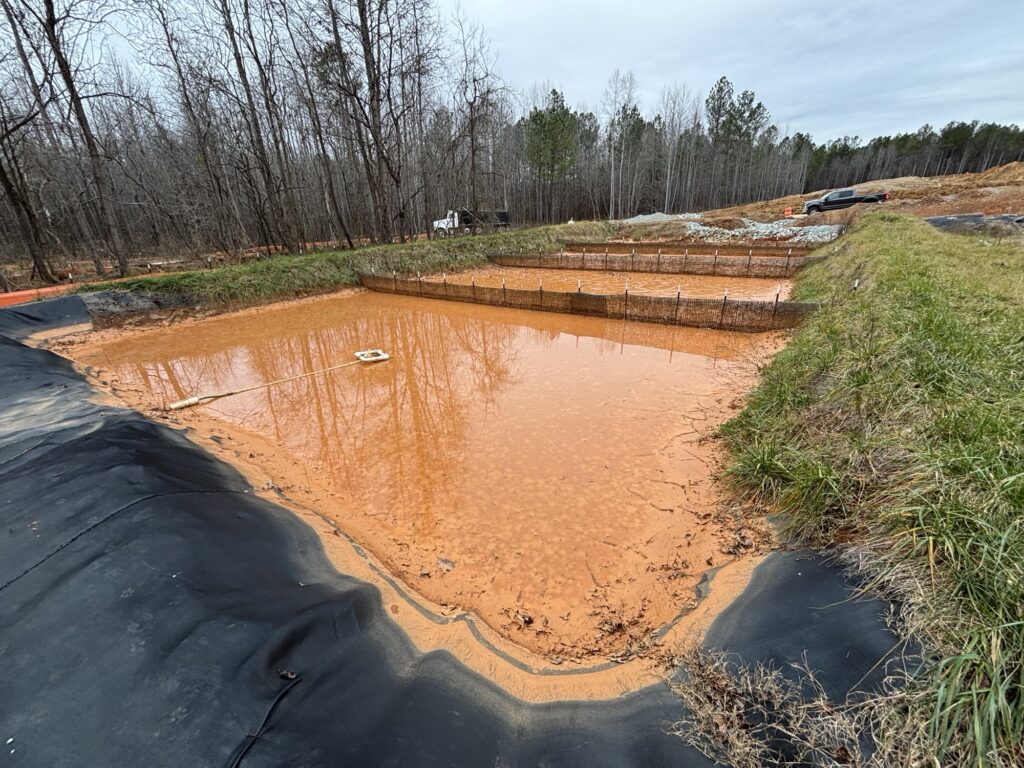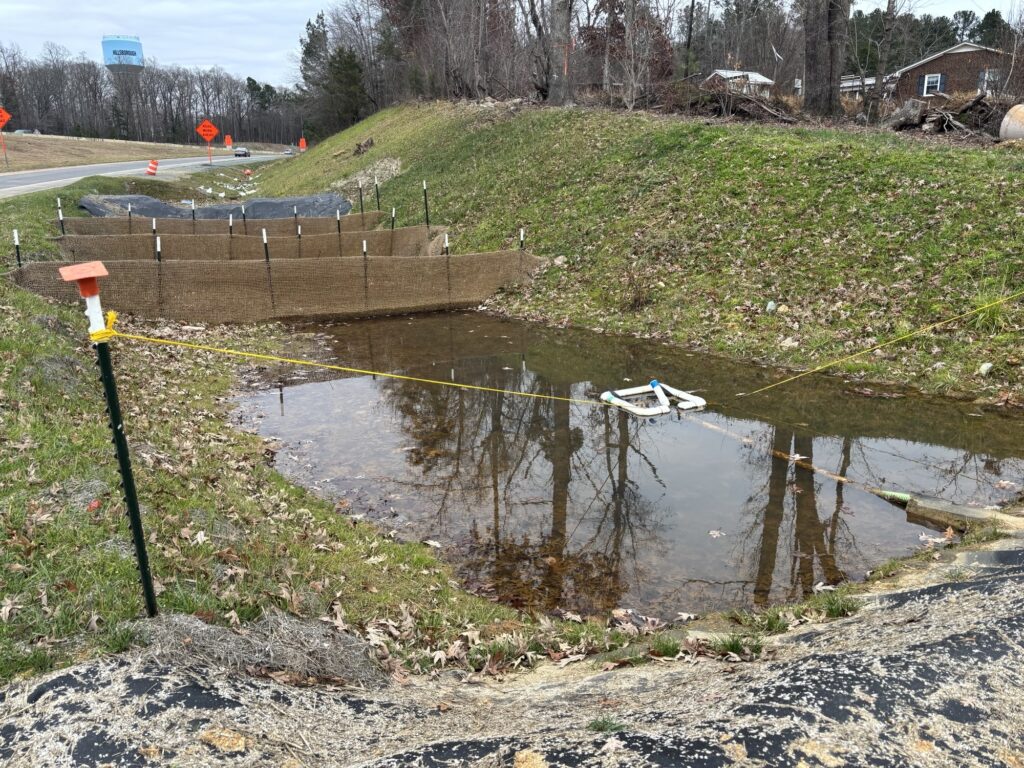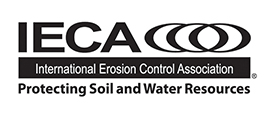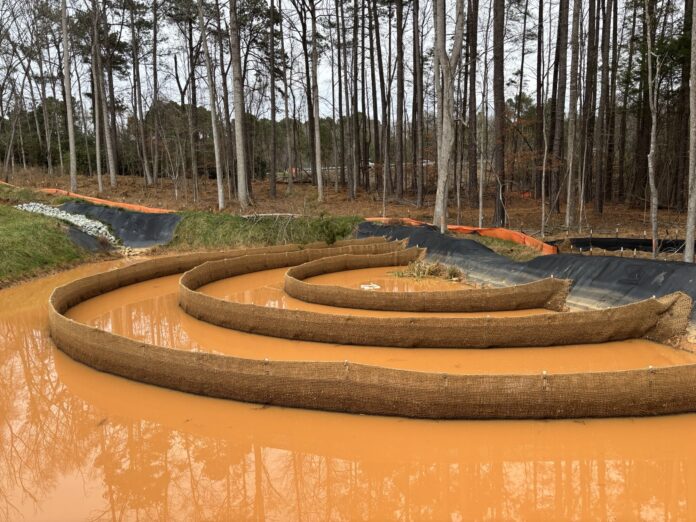Sediment basins are temporary sediment and erosion control measures designed to capture stormwater runoff on construction sites before off-site discharge. The primary function of these basins is to provide storage volume and time to promote the gravitational settling of soil particles suspended in stormwater runoff. Once these particles fall out of suspension and accumulate on the bottom of the basin, the remaining clarified water can be safely discharged off-site.
These enhancements aim to extend the lifespan of construction exit pads and improve their efficiency, particularly in high-traffic construction sites.
A well-designed sediment basin consists of four main parts: an inflow channel, a settling pond with porous baffles, a dewatering device and an auxiliary spillway.
Part One: Inflow Channel
The inflow channel is a channel that collects stormwater and conveys water in a controlled fashion to the inlet of the basin. Temporary or permanent stabilization is important throughout the length of the inflow channel to prevent erosion. Protecting the channel with vegetation, geotextile liners or riprap in place will prevent the channel itself from becoming a source of sediment (Figure 1).
Installing ditch checks along the inflow channel allows for initial dissipation and collection of sediment. Capturing rapidly settling soil particles before they enter the basin provides more room in the basin for the finer sediment particles to settle. This initial treatment facilitates access for maintenance, which allows sediment to be removed more frequently without the use of heavy machinery.
Part Two: Basin (Settling Pond)
The preferred shape of a sediment basin is rectangular; however, depending on site conditions and topographic restraints, different shapes may be employed. Designing a basin with a length-to-width ratio of 2:1 or greater will create a longer flow path from the inflow to the outflow of the basin, which gives more time for settling to occur before off-site discharge. As with the inflow channel, stabilization of the inlet and the side slopes will prevent increasing turbidity levels from erosion occurring in the basin.
The volume of the basin is split into different zones. At the bottom of the basin is a standing pool, a permanent volume of water designed not to dewater but only to infiltrate or evaporate. This pool serves to detain the water with the highest concentration of sediment for an extended period, which allows for additional sedimentation to occur. This process also serves to slow water as it enters the basin, which reduces turbulence and the risk of resuspension of already-accumulated sediment in the basin.
Above the standing pool is the stormwater storage, which is the volume of the basin designed to be dewatered by the primary dewatering device. This volume should be 3600 feet3 (102 m3) per acre of the total drainage area of the site or designed to handle a two-year 24-hour storm, and it extends from the elevation of the primary outlet to the bottom of auxiliary spillway.
At the top of the basin is additional storage designed to discharge over the auxiliary spillway when flow rates and/or flow volume are beyond the capacity of the primary dewatering device. This storage should be designed to handle a 10-year 24-hour storm peak flow rate.
Lastly, designing some freeboard above the auxiliary spillway volume allows for water to be contained within the basin and not overflow during heavy storms.

Promote Sedimentation: Porous Baffle
Typical flow in a basin without baffles would see high-speed runoff enter the basin and move at a high velocity down the middle of the basin toward the outlet, which increases overall turbulence while ignoring using the sides of the basin for sediment settling. Porous baffles serve to improve the efficiency of sediment basins by spreading flow across the entire width of the sediment basin and slowing flow velocity to facilitate gravitational settling.
Initial flow into the basin will generally be turbulent, and when there is turbulence, there inhibits the ability of sediment to settle to the bottom of the basin easily. Water that makes its way through a porous baffle will see its turbulent flow converted to laminar flow, and with laminar flow comes smooth sheets of water flowing on top of each other with little to no turbulence, creating conditions ideal for settling to occur.
A minimum of three porous baffles should be installed perpendicularly to the flow of water between the inlet and the outlet to ensure the entire surface area of the basin is used for settling (Figure 2). One effective material for baffles is coir fiber matting sized between 700 to 900g/m2 (21 to 27 oz/yard3). Baffles should be installed so they are fully extended into the side slopes and the bottom of the basin and at a height that matches the depth of the flow over the auxiliary spillway. Flow should not be allowed under, over or around the baffles.
Part Three: Primary Dewatering Outlet
In a basin, as water settles to the bottom of the pond, the water at the surface will always have the lowest concentration of sediment. Therefore, basins must be dewatered from the top of the water column. The preferred method to accomplish dewatering from the surface is with a surface skimmer.
Skimmers float on the surface of the water. They rely on gravity to remove water from the surface and make it flow through their plumbing and eventually through the outlet of the basin. The skimmer rises and falls as the basin fills and drains. The size of the orifice of the skimmer controls the rate at which the basin is dewatered. The design dewatering time of a basin is two to six days. Dividing the stormwater storage of the basin by this dewatering time will determine the necessary flow rate for the skimmer. It is important to list the manufacturer of the skimmer used as the basis for design on project plans. This ensures that the skimmer with the appropriate flow rate is installed in the basin.
Skimmers should be installed near the outlet of the basin to allow for maximum flow time for water from inflow to outflow (Figure 3). Giving the skimmer something to rest on, like a bed of riprap or a dewatering pad, will keep the skimmer from getting mired in sediment when it is at the bottom of the basin.
Part Four: Auxiliary Spillway
Auxiliary spillways are put in place to allow excess water to safely bypass the basin when full, and they should be installed in every sediment basin. As with skimmers, these should be installed as far as possible from the inlet to maximize flow length. The spillway should be designed for a 10-year 24-hour storm peak flow rate. Also, as with other parts of the basin, it should be stabilized with nonerosive liner, vegetative cover, or stone to minimize erosion.

About the Expert
Matthew Love is the inside sales manager at Faircloth Skimmer. He has certifications for stormwater control measure inspection and maintenance and level I erosion and sediment control in North Carolina.







